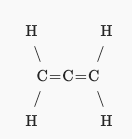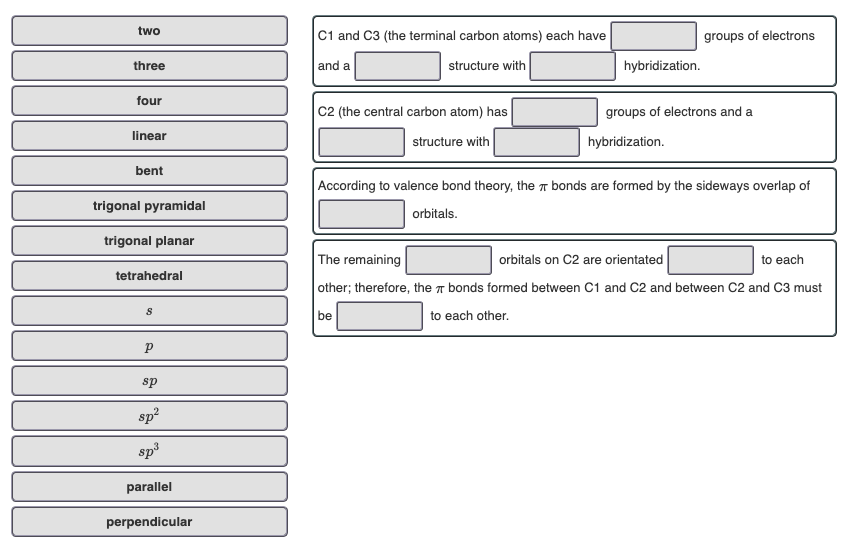two C1 and C3 (the terminal carbon atoms) each have groups of electrons and a structure with hybridization. three four C2 (the central carbon atom) has groups of electrons and a linear structure with hybridization. bent According to valence bond theory, the bonds are formed by the sideways overlap of trigonal pyramidal orbitals. trigonal planar The remaining other; therefore, the T bonds formed between C1 and C2 and between C2 and C3 must orbitals on C2 are orientated to each tetrahedral be to each other. sp sp sp parallel perpendicular
two C1 and C3 (the terminal carbon atoms) each have groups of electrons and a structure with hybridization. three four C2 (the central carbon atom) has groups of electrons and a linear structure with hybridization. bent According to valence bond theory, the bonds are formed by the sideways overlap of trigonal pyramidal orbitals. trigonal planar The remaining other; therefore, the T bonds formed between C1 and C2 and between C2 and C3 must orbitals on C2 are orientated to each tetrahedral be to each other. sp sp sp parallel perpendicular
Principles of Modern Chemistry
8th Edition
ISBN:9781305079113
Author:David W. Oxtoby, H. Pat Gillis, Laurie J. Butler
Publisher:David W. Oxtoby, H. Pat Gillis, Laurie J. Butler
Chapter6: Quantum Mechanics And Molecular Structure
Section: Chapter Questions
Problem 61P: Discuss the nature of the bonding in the nitrite ion (NO2) . Draw the possible Lewis resonance...
Related questions
Question
100%

Transcribed Image Text:H
H
C=C=C
H
H

Transcribed Image Text:two
C1 and C3 (the terminal carbon atoms) each have
groups of electrons
and a
structure with
hybridization.
three
four
C2 (the central carbon atom) has
groups of electrons and a
linear
structure with
hybridization.
bent
According to valence bond theory, the bonds are formed by the sideways overlap of
trigonal pyramidal
orbitals.
trigonal planar
The remaining
other; therefore, the T bonds formed between C1 and C2 and between C2 and C3 must
orbitals on C2 are orientated
to each
tetrahedral
be
to each other.
sp
sp?
sp3
parallel
perpendicular
Expert Solution
This question has been solved!
Explore an expertly crafted, step-by-step solution for a thorough understanding of key concepts.
This is a popular solution!
Trending now
This is a popular solution!
Step by step
Solved in 2 steps

Knowledge Booster
Learn more about
Need a deep-dive on the concept behind this application? Look no further. Learn more about this topic, chemistry and related others by exploring similar questions and additional content below.Recommended textbooks for you

Principles of Modern Chemistry
Chemistry
ISBN:
9781305079113
Author:
David W. Oxtoby, H. Pat Gillis, Laurie J. Butler
Publisher:
Cengage Learning

Organic Chemistry
Chemistry
ISBN:
9781305580350
Author:
William H. Brown, Brent L. Iverson, Eric Anslyn, Christopher S. Foote
Publisher:
Cengage Learning

Chemistry: The Molecular Science
Chemistry
ISBN:
9781285199047
Author:
John W. Moore, Conrad L. Stanitski
Publisher:
Cengage Learning

Principles of Modern Chemistry
Chemistry
ISBN:
9781305079113
Author:
David W. Oxtoby, H. Pat Gillis, Laurie J. Butler
Publisher:
Cengage Learning

Organic Chemistry
Chemistry
ISBN:
9781305580350
Author:
William H. Brown, Brent L. Iverson, Eric Anslyn, Christopher S. Foote
Publisher:
Cengage Learning

Chemistry: The Molecular Science
Chemistry
ISBN:
9781285199047
Author:
John W. Moore, Conrad L. Stanitski
Publisher:
Cengage Learning

Organic Chemistry: A Guided Inquiry
Chemistry
ISBN:
9780618974122
Author:
Andrei Straumanis
Publisher:
Cengage Learning

Chemistry: Principles and Reactions
Chemistry
ISBN:
9781305079373
Author:
William L. Masterton, Cecile N. Hurley
Publisher:
Cengage Learning

Chemistry & Chemical Reactivity
Chemistry
ISBN:
9781337399074
Author:
John C. Kotz, Paul M. Treichel, John Townsend, David Treichel
Publisher:
Cengage Learning